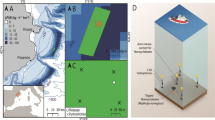Abstract
The movements of seabream (Sparus aurata L) were recorded in two earthen ponds (250 m2 and 400 m2) by tracking fish tagged with miniature acoustic transmitters. Five seabreams, 500 g in weight, were tracked for periods of four or five days. Fish positions were recorded continuously using an acoustic telemetry system. Each of the five tagged seabreams were tracked individually. Two fishes were released schooled with numerous other individuals, two others were released in isolation and one was grouped with three other individuals.
The schooled seabreams were more active in general and, in the large school they were diurnal; isolated fishes however, were more active at night. Temperature influences significantly and progressively the fish activity. Activity decreases at night and increases during daylight. Oxygen saturation also influences swimming activity with a general positive relationship.
The horizontal distribution of this species was not uniform. Its resting area was generally located around some particular landmarks such as inlet or outlet pipes in the ponds. No feverish feeding competition was observed between individuals of the same school. The feeding area was cleaned rapidly, in less than 10 minutes, without subsequent returns from the resting area to the feeding area.
Résumé
Les déplacements de la daurade (Sparus aurata L.) ont été enregistrés dans deux bassins en terre (250 m2 et 400 m2) en suivant des poissons marqués avec des émetteurs acoustiques miniaturisés. Cinq daurades d'un poids individuel de 500 g furent suivies durant des périodes de 4 ou 5 jours. Les positions des poissons ont été enregistrées en continu avec un systéme de télémétrie acoustique. Chacun des cinq poissons marqués fut suivi individuellement. Deux poissons furent regroupés avec de nombreux autres individus, deux autres furent laissés seuls et le dernier fut mis avec trois autres individus.
Les daurades groupées étaient en général plus actives et, en grand banc, étaient diurnes; les poissons isolés étaient toutefois plus actifs durant la nuit. La température influence significativement et progressivement l'activité des poissons. L'activité décroît durant la nuit et augmente pendant le jour. Le pourcentage de saturation en oxygéne agit aussi, de façon positive, sur l'activité de nage.
La distribution horizontale de cette espéce n'est pas uniforme. Son aire de repos est généralement localisée dans quelques zones particuliéres comme les arrivées et les sorties d'eau. Aucune compétition alimentaire fébrile n'a été observée entre les individus d'un même banc. L'aire de nourrissage est rapidement nettoyée, en moins de 10 minutes, sans retours ultérieurs depuis la zone de repos jusqu' à la zone de nourrissage.
Similar content being viewed by others
References
Alabaster, J. S. & K. G. Robertson, 1961. The effects of diurnal changes in temperature, dissolved oxygen and illumination on the behaviour of roach (Rutilus rutilus (L.)), bream (Abramis abrama (L.)) and perch (Perca fluviatilis (L.)). Anim. Behav. 9: 187–192.
Breder, C. M., 1959. Studies on social groupings in fishes. Bull. am. Mus. nat. Hist. 117: 399–481.
Cunjak, A. R. & G. Power, 1987. Cover use by stream-resident trout in winter: a field experiment. North amer. J. Fish. Mgmt 7: 539–544.
Hawkins, A. D., D. N. MacLennan, G. G. Urquhart & C. Robb, 1974. Tracking cod Gadus morhua L. in a Scottish sea loch. J. Fish Biol. 6: 225–236.
Holand, B., I. Mohus & R. Berntsen, 1974. Fish elemetry, foundation for scientific and industrial esearch at the Norvegian institute of technology, Tröndheim. SINTEF rep. STF (A 74049), 89 pp.
Kanda, T. & M. Tanaka, 1992. Effects of number of fish in a group, shape of respiratory chamber, and locomotory activity on oxygen consumption of striped mullet Mugil cephalus. Nippon Suisan Gakkaishi 58: 1827–1831.
Kieffer, J. D. & P. W. Colgan, 1992. The role of learning in fish behaviour. Rev. Fish Biol. Fish. 2: 125–143.
Kleerekoper, H., A. M. Timms, G. F. Westlake, F. B. Davy, T. Malar & V. M. Anderson, 1970. An analysis of locomoto behaviour of goldfish (Carassius auratus). Anim. Behav., 18: 317–330.
Lagardère, J. P., J. J. Ducamp, L. Frikha & M. Sperandio, 1988. Ultrasonic tracking of common juveniles (Solea vulgaris Quensel, 1806) in a saltmarsh: methods and fish response to ome environmental factors. J. appl. Ichthyol. 4: 87–96.
Lagardère, J. P., J. J. Ducamp, L. Favre, J. Mosneron Dupin & M. Sperandio, 1990. A method for the quantitative evaluation of fish movements in salt ponds by acoustic telemetry. J. exp. mar. Biol. ecol. 141: 221–236.
Reese, E. S., 1989. Orientation behavior of butterflyfishes (family Chaetodontidae) on coral reefs: spatial learning of rout specific landmarks and cognitive maps. Envir. Biol. Fish 250: 79–86.
Rosecchi, E., 1985. L'alimentation de Diplodus annularis, Diplodus sargus, Diplodus vulgaris et Sparus aurata (Pisces, Sparidae) dans le golfe du Lion et les lagunes littorales. Rev. Trav. Inst. Pêches marit. 49: 125–141.
Stirling, H. P., 1977. Growth, food utilization and effect of social interaction in the European bass Dicentrarchus labrax. Mar. Biol. 40: 173–184.
Wassef, E. & A. Eisawy, 1985. Food and feeding habits of wild and reared gilthead bream Sparus aurata L. Cybium 9: 233–242.
Author information
Authors and Affiliations
Rights and permissions
About this article
Cite this article
Bégout, ML., Lagardére, JP. An acoustic telemetry study of seabream (Sparus aurata L.): first results on activity rhythm, effects of environmental variables and space utilization. Hydrobiologia 300, 417–423 (1995). https://doi.org/10.1007/BF00024483
Issue Date:
DOI: https://doi.org/10.1007/BF00024483




